Hobby trivia: most used newspaper titles…
June 29, 2009 by TimHughes · 1 Comment
 By far the most common of early titles were “Gazette” and then “Advertiser“. Between 1704 and 1820 “Gazette” was used either by itself or as part of a newspaper title 488 times. This was closely followed by “Advertiser” with 440 times, showing the deference which publishers paid to their advertisers who made up the greater part of a newspaper’s profit.
By far the most common of early titles were “Gazette” and then “Advertiser“. Between 1704 and 1820 “Gazette” was used either by itself or as part of a newspaper title 488 times. This was closely followed by “Advertiser” with 440 times, showing the deference which publishers paid to their advertisers who made up the greater part of a newspaper’s profit.
These two titles were followed by “Herald” with 115 times, “Journal” 114, “Intelligencer” 104, “Register” 86, “Republican” 77, “Chronicle” 75, “Patriot” 57, “Centinel” or “Sentinel” 56, and “Courier” 45.
Titles frequently used, but in lesser number, were “Eagle“, “Mercury“, “Messenger“, “Monitor“, “Museum“, “Observer“, “Post“, “Recorder“, “Repository“, “Star” and “Times“.
It is curious that “Times” was rarely used before 1820, and there is no mention whatever of “Tribune” or “Transcript“, all somewhat common within newspaper titles today.
(The above is excerpted from the book “Journals and Journeymen” by Clarence Brigham)
A 19th century alternative to divorce…
June 27, 2009 by TimHughes · Leave a Comment
 The “New York Transcript” newspaper of March 19, 1836 included an article reporting divorce cases in New Jersey. More than just reporting the news, the editor chose to take considerable license in expressing his own opinion, providing a bit of comedy for us more than 170 years later.
The “New York Transcript” newspaper of March 19, 1836 included an article reporting divorce cases in New Jersey. More than just reporting the news, the editor chose to take considerable license in expressing his own opinion, providing a bit of comedy for us more than 170 years later.
My Collecting Story… Glenn Guttman…
June 25, 2009 by GuyHeilenman · Leave a Comment
The High Point of My Collecting Experience:
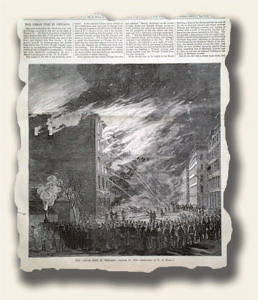
I started collecting “antique” newspapers after responding to an ad in the back of a Coin World magazine where Tim Hughes was offering his latest catalog of old newspapers. I was amazed at the variety of selections available, the reasonableness of the prices for items that were well over 100 years of age and the beauty of many of the features within the pages of the newspapers.
As a native of Chicago, one of the first items I purchased back in the early 90’s was a Harper’s Weekly dating back to 1871, just a couple of weeks after the Great Chicago Fire. I had purchased the item in very good condition from Tim for around $30-45 as I recall. The issue was chock full of many interesting items surrounding details of the Great Fire, how it started, what area it consumed, engravings of the landscape after the fire, etc. There were a couple of Nast cartoons as I recall in the magazine (newspaper) as well. Overall, a very interesting piece.
One day, I had heard the “Antiques Roadshow” was filming in Chicago, at Navy Pier and my wife and I decided to go with two items. She brought this intricate and delicately framed picture which was created out of shiny silk stitching that was unlike anything I (or anyone else) had ever seen. Truly a unique item.
We also brought my Harper’s Weekly to get an idea as to its value from an independent appraiser.
After about 2 hours of standing in line, finally someone came to analyze the items brought in by my wife and I. A woman saw what my wife had and was quite intrigued and asked if it could be reviewed by the art expert. We were taken out of line and my wife and I started “high-fiving” each other thinking we had hit the jackpot with our great find. Once looked at by the art appraiser, our hopes were deflated once we learned that our picture was a widely produced, and factory manufactured piece of no intrinsic value whatsoever. A complete bust in terms of value. Maybe worth $20 the expert stated.
Next, my newspaper and I were taken to a review appraiser who looked at the item carefully, smiling all the while, but saying nothing. He then spoke to what turned out to be one of the on-set producers and then came to us and asked if we were interested in being taped for the show with our item. They said it was a fascinating piece and that being filmed in Chicago, with an article of such local interest, it would be a wonderful addition to the show. We accepted the invitation and took a seat awaiting our turn to discuss the item on camera.
Three more hours passed and nothing was happening. Despite our numerous requests to get an idea as to when we would be called to begin filming, we received no information. We were hungry, tired, and had been sitting/standing/sitting and fidgeting for over 5 hours with no clue as to when our “15 minutes of fame” would occur. Finally, my wife said she had had it and that it was time to go. We informed the producer of our intent to leave and asked that our item be appraised if possible. The producer tried to persuade us to continue to wait, but enough time had elapsed to fill a double-header in baseball, with no indication that we would ever be called to the camera.
Anyway, about a half-hour later, the appraiser came and took a look at the item again, went through the many details he had noticed which made the magazine (newspaper) so interesting. And five minutes later he told us that the newspaper we purchased, in the Chicagoland area, if offered at auction, would probably fetch an offer of around $200 by his estimation.
It was a day I rather enjoyed but for the exasperating wait for many hours.
Thanks Tim for offering such great pieces of history to the public and sharing your passion with the rest of the world. It’s provided many years of fun.
– – – – – – – – – – – – – – – – – – – – – – – – – – – – – – – – – – – – – – – – – –
Thanks for sharing your story Glenn. If you would like to share your story of how you became interested in collecting rare and/or historic newspapers, e-mail it to guy@rarenewspapers.com and place “My Story” in the subject field. Although not necessary, feel free to include an image. Please do not include your e-mail address or a personal website as part of the text of your story. We will post collector stories every few weeks and will send you a notice when your story appears. Thank you for your contribution to the community.
Media Transformation…
June 22, 2009 by GuyHeilenman · Leave a Comment
 From Benjamin Harris’ papers of the seventeenth century to the modern day media centers online and on TV, the newspaper has undergone a drastic change in style. The true transition began when America broke free of British news in 1783 and established the Pennsylvania evening Post as the first American daily. The many papers published in between these early years were deeply rooted in cultural ideals as well as secrecy from the British Empire depending on the time frame. The rise to the media outlets as we know them to be today has been a long time coming but is the best form of news to fit modern society.
From Benjamin Harris’ papers of the seventeenth century to the modern day media centers online and on TV, the newspaper has undergone a drastic change in style. The true transition began when America broke free of British news in 1783 and established the Pennsylvania evening Post as the first American daily. The many papers published in between these early years were deeply rooted in cultural ideals as well as secrecy from the British Empire depending on the time frame. The rise to the media outlets as we know them to be today has been a long time coming but is the best form of news to fit modern society.
Isaiah Thomas’ Massachusetts Spy was one such paper that was secretly published within 1770 and 1776 during the American Revolution. Many similar papers were published during this time, albeit a difficult time in which to publish any type of paper with a continuous circulation. Many papers did not survive past a few months and those that did were changed to Royalist perspectives due to the British occupancy. However, after the independence of 1776, papers began to experience the freedom they so craved from the tyranny of an overseas empire. These new papers united resistance to oppression, praised patriotism, and denounced tyranny, often making the papers themselves a bit more radical than the majority of the population. These papers often served to unify the general public which proved to be a general step in the right direction when instating a nation.
The later eighteenth century saw the rise of partisan papers and political parties began to take shape. Federalist and Republican presses dominated different realms of the nation and proved to reach out to constituents in an easy way. This time period cemented the newspaper ideals and molded the reporting to be what we now know it to be: local affairs and the rivalry of competitors which has since become a dominant force in American journalism. With the increased annexation of states, the newspaper audience grew as more and more citizens joined the ranks of the United States. These early papers of the West were often poorly written but served to provide an outlet for these new national citizens in which to approach their Congressman and get their voices heard. This is what the news was originally about, catering to a smaller local audience in order to get their voices heard on a national scale in the end. After this original introduction of papers around the United States, they have since grown into larger entities that are all-encompassing.
“Yellow Journalism” and muckraking are terms of the later nineteenth and twentieth century which have helped to cement the importance of journalism in American society. Yellow journalism references journalism that features scandal-mongering, sensationalism, or other unethical antics by news media organizations; muckraker refers to an individual who investigates and exposes issues of corruption that violate previous societal ethical values. The original Yellow Journalism battle began between Joseph Pulitzer’s New York World and William Randolph Hearst’s New York Journal. These type of battles remain in existence today between rival news networks although they are no longer central to newspaper in print. The move from print papers to online and televised news accounts has made an extraordinary difference in the modern world. Most modern day businessmen do not have the time to read an entire newspaper which has since tripled in length, but can hear the snippets of news on the radio or from a news station on TV; furthermore, they can always go online and click the top headlines of the day. This transformation in the media world is a telling sign of the shift in technology that we have yet to fully realize the significance of.
This post was contributed by Meredith Walker, who writes about the BachelorsDegreeOnline.com. She welcomes your feedback at MeredithWalker1983@gmail.com.
The trek from boyhood to manhood…
June 20, 2009 by TimHughes · Leave a Comment
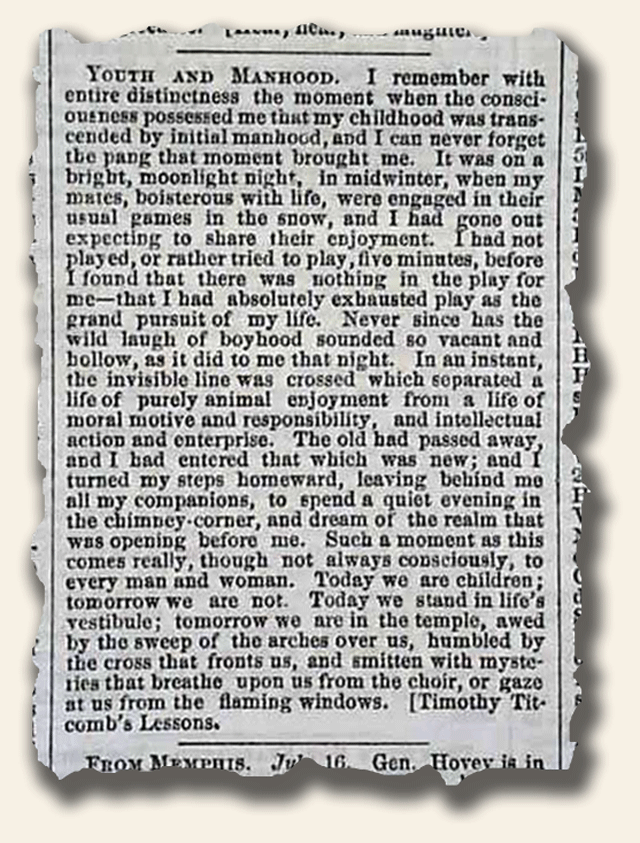 The Boston Evening Transcript of July 21, 1862 has an interesting article on the front page headed “Youth And Manhood”, which is the writer’s reflection upon how–for him–the step from youth to manhood was a singular, notable
The Boston Evening Transcript of July 21, 1862 has an interesting article on the front page headed “Youth And Manhood”, which is the writer’s reflection upon how–for him–the step from youth to manhood was a singular, notable
“Today we are children; tomorrow we are not. Today we stand in life’s vestibule; tomorrow we are in the temple… awed… humbled… and smitten…”
Although a bit morose in tone, it is nicely written and worth sharing.
The time lag in news reporting, 1776…
June 18, 2009 by TimHughes · 6 Comments
Communication throughout the colonies in the 18th century was a slow process, particularly in winter. It took postriders a week to journey from New York to Boston, at least two days from Philadelphia to New York, and two weeks or more to the Southern states.
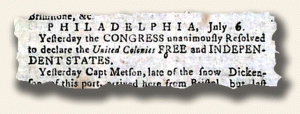 A good example of the slowness of mail delivery is revealed by an analysis of the printing of the Declaration of Independence in the various colonial newspapers. The first printing was in the Pennsylvania Evening Post of July 6. Three days later it appeared in Baltimore, and four days later in New York.
A good example of the slowness of mail delivery is revealed by an analysis of the printing of the Declaration of Independence in the various colonial newspapers. The first printing was in the Pennsylvania Evening Post of July 6. Three days later it appeared in Baltimore, and four days later in New York.
The list below gives some indication of the time lag distances required, but it should be remembered that the printing often had to await the proper day of the newspaper’s publications as many were just weekly while others were bi-weekly or tri-weekly, although a few of the papers published “extraordinary” issues.
DECLARATION OF INDEPENDENCE NEWSPAPER PRINTINGS
July 6 Philadelphia, Pennsylvania Evening Post
July 8 Philadelphia, Dunlap’s Pennsylvania Packet
July 9 Philadelphia, Pennsylvanischer Staatsbote
July 9 Baltimore, Dunlap’s Maryland Gazette
July 10 Baltimore, Maryland Journal
July 10 Philadelphia, Pennsylvania Gazette
July 10 New York, Constitutional Gazette
July 11 New York Packet
July 11 New York Journal
July 11 Annap0lis, Maryland Gazette
July 12 New London, Connecticut Gazette
July 13 Philadelphia, Pennsylvania Ledger
July 13 Providence Gazette
July 15 New York Gazette
July 15 Hartford, Connecticut Courant
July 15 Norwich Packet
July 16 Exeter, New Hampshire Gazette, Extraordinary
July 16 Salem, American Gazette
July 17 Worcester, Massachusetts Spy
July 17 New Haven, Connecticut Journal
July 18 Boston, Continental Journal
July 18 Boston, New England Chronicle
July 18 Newport Mercury, Extraordinary
July 19 Newburyport, Essex Journal
July 19 Williamsburg, Virginia Gazette by Purdie (extract; in full July 26)
July 20 Williamsburg, Virginia Gazette by Dixon & Hunter
July 20 Portsmouth, Freeman’s Journal
July 22 Watertown, Boston Gazette
Aug. 2 Charleston, South Carolina & American General Gazette
Aug. 17 London, The London Chronicle
Charles Dickens on newspapers…
June 15, 2009 by TimHughes · 3 Comments
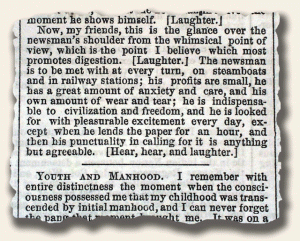 The Boston Evening Transcript of July 21, 1862, has a front page article “Charles Dickens on Newspapers”, a speech he delivered in London at the Newsvenders’ Benevolent Institution. The lengthy speech takes two-thirds of a column and is filled with witty comments, and ends with: “…The newsman is to be meet with at every turn, on steamboats and in railway stations; his profits are small…he is indispensable to civilzation and freedom, and he is looked for with peasurable excitement every day…”.
The Boston Evening Transcript of July 21, 1862, has a front page article “Charles Dickens on Newspapers”, a speech he delivered in London at the Newsvenders’ Benevolent Institution. The lengthy speech takes two-thirds of a column and is filled with witty comments, and ends with: “…The newsman is to be meet with at every turn, on steamboats and in railway stations; his profits are small…he is indispensable to civilzation and freedom, and he is looked for with peasurable excitement every day…”.
Male chauvinism has its drawbacks…
June 13, 2009 by TimHughes · 1 Comment
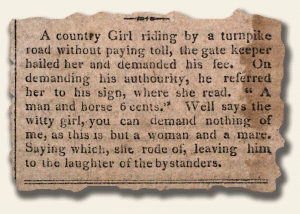 The newspaper with a curious title of “The Tickler” from Philadelphia, January 22, 1812, contains a comical little item at the bottom of the back page. Little “treats” such as these may be found throughout old newspapers. See the photo.
The newspaper with a curious title of “The Tickler” from Philadelphia, January 22, 1812, contains a comical little item at the bottom of the back page. Little “treats” such as these may be found throughout old newspapers. See the photo.
Exploring the world of old paper…
June 12, 2009 by GuyHeilenman · Leave a Comment
 Marty Weil, a freelance writer and journalist, maintains the informative blog, “ephemera… exploring the world of old paper“. Today he is featuring a guest post from our very own Tim Hughes. To view the post, go to “Old Newspapers as a Collectible“. Thanks Marty, for expanding the ephemera world’s understanding of historic and collectible newspapers.
Marty Weil, a freelance writer and journalist, maintains the informative blog, “ephemera… exploring the world of old paper“. Today he is featuring a guest post from our very own Tim Hughes. To view the post, go to “Old Newspapers as a Collectible“. Thanks Marty, for expanding the ephemera world’s understanding of historic and collectible newspapers.
About Marty Weil: He has written more than 250 magazine features on a variety of subjects. Articles written by Marty Weil have appeared in more than two dozen publications, including Fortune, Managing Automation, Antique Week, APICS, and Scholastic Administrator. Previously, he was the President of Weil Marketing Communications Inc., a successful high-tech PR consulting firm. He is a graduate of Illinois State University.
My Collecting Story… Brent Lacy…
June 11, 2009 by GuyHeilenman · 1 Comment
 I began collecting a few papers several years ago, by way of genealogy. For years I had been researching my family tree, started by an obituary of my gg-grandfather that mentioned that he fought in the civil war and was from Kentucky. Research led me to find out many things about where he came from and also some records from the war. One thing I found out was the unit he was fighting with and date that he was taken prisoner. To put together a book for the family, I began to look for more information to fill out the story other than who begat who. During this time I found old newspapers I began to look for anything that mentioned his commander or unit and papers around the time of his capture. What I found was amazing several papers from the days before and after contained first hand accounts and reports of the battles he was in. Information on where they were on specific days and time and what they were encountering told at the time, became invaluable to filling out his story. One story in particular locked me in, one that told of troops sneaking upon the enemy (my ancestors unit) early one morning and taking several prisoners. That was the day my ancestor was taken captive, and here was a newspaper article from 1864 describing the actual event. This was news of the day written in the day, not some glossed over or condensed history book and who knows he could have possibly read the same newspaper article at some point! I was hooked. I still look for things related to him and also now look for what was going on in other locales where other ancestors lived. It has made for fascinating genealogical research to see what was reported then and what they would have been seeing as current news, filling out the story of our ancestors lives. Well that’s my story. I am thankful for the www.rarenewspapers website.
I began collecting a few papers several years ago, by way of genealogy. For years I had been researching my family tree, started by an obituary of my gg-grandfather that mentioned that he fought in the civil war and was from Kentucky. Research led me to find out many things about where he came from and also some records from the war. One thing I found out was the unit he was fighting with and date that he was taken prisoner. To put together a book for the family, I began to look for more information to fill out the story other than who begat who. During this time I found old newspapers I began to look for anything that mentioned his commander or unit and papers around the time of his capture. What I found was amazing several papers from the days before and after contained first hand accounts and reports of the battles he was in. Information on where they were on specific days and time and what they were encountering told at the time, became invaluable to filling out his story. One story in particular locked me in, one that told of troops sneaking upon the enemy (my ancestors unit) early one morning and taking several prisoners. That was the day my ancestor was taken captive, and here was a newspaper article from 1864 describing the actual event. This was news of the day written in the day, not some glossed over or condensed history book and who knows he could have possibly read the same newspaper article at some point! I was hooked. I still look for things related to him and also now look for what was going on in other locales where other ancestors lived. It has made for fascinating genealogical research to see what was reported then and what they would have been seeing as current news, filling out the story of our ancestors lives. Well that’s my story. I am thankful for the www.rarenewspapers website.
– – – – – – – – – – – – – – – – – – – – – – – – – – – – – – – – – – – – – – – – – –
Thanks for sharing your story Brent. If you would like to share your story of how you became interested in collecting rare and/or historic newspapers, e-mail it to guy@rarenewspapers.com and place “My Story” in the subject field. Although not necessary, feel free to include an image. Please do not include your e-mail address or a personal website as part of the text of your story. We will post collector stories every few weeks and will send you a notice when your story appears. Thank you for your contribution to the community.


